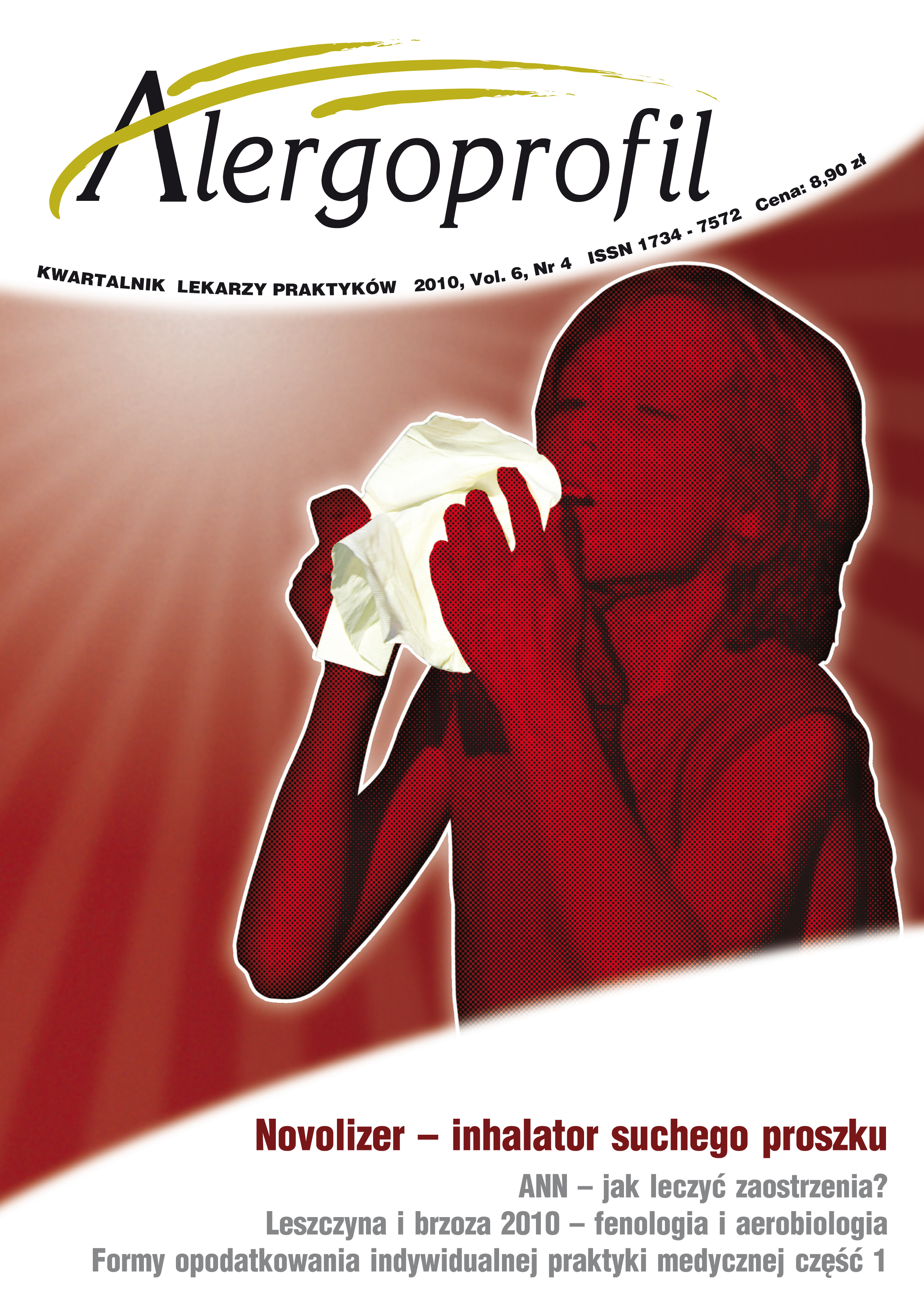Reakcje nadwrażliwości na leki znieczulenia miejscowego ze szczególnym uwzględnieniem lidokainy
##plugins.themes.bootstrap3.article.main##
Abstrakt
Środki znieczulenia miejscowego (LAs, local anaesthetics) są obecnie powszechnie stosowane w wielu gałęziach medycyny, m.in.: stomatologii, chirurgii, urologii, ginekologii, położnictwie, ortopedii, umożliwiają bezpieczne i bezbolesne przeprowadzenie zabiegów bez konieczności stosowania znieczulenia ogólnego. Pod względem struktury chemicznej leki te są pochodnymi amidowymi lub estrami kwasu paraaminobenzoesowego. Najpopularniejsza z pochodnych amidowych, lidokaina, stosowana jest jako roztwór do iniekcji w postaci chlorowodorku w stężeniu 1% lub 2% z dodatkiem adrenaliny lub bez. Poza zastosowaniem w anestezji lidokaina jest sprawdzonym lekiem antyarytmicznym. Reakcje niepożądane po zastosowaniu LAs mogą być związane z dożylnym podaniem leku, zastosowaniem dawek toksycznych, wystąpieniem reakcji nadwrażliwości lub reakcji psychogennej. Prawdziwe reakcje nadwrażliwości na leki znieczulenia miejscowego są rzadkie (mniej niż 1% wszystkich reakcji niepożądanych) i należą do typu I lub IV reakcji nadwrażliwości według klasyfikacji Gella i Coombsa. Do metod stosowanych w diagnostyce nadwrażliwości na leki znieczulenia miejscowego należą testy punktowe, testy śródskórne oraz podskórne testy prowokacyjne.
Pobrania
##plugins.themes.bootstrap3.article.details##
Copyright: © Medical Education sp. z o.o. This is an Open Access article distributed under the terms of the Attribution-NonCommercial 4.0 International (CC BY-NC 4.0). License (https://creativecommons.org/licenses/by-nc/4.0/), allowing third parties to copy and redistribute the material in any medium or format and to remix, transform, and build upon the material, provided the original work is properly cited and states its license.
Address reprint requests to: Medical Education, Marcin Kuźma (marcin.kuzma@mededu.pl)
Bibliografia
2. Podstawy alergologii. Mędrala W. (red.). Górnicki Wydawnictwo Medyczne, Wrocław 2006: 20- 23.
3. González-Delgado P., Antón R., Soriano V. et al.: Cross-Reactivity Among Amide-Type Local Anesthetics in a Case of Allergy to Mepivacaine. J. Investig. Allergol. Clin. Immunol. 2006, 16: 311-313.
4. Malanin K., Kalimo K.: Hypersensitivity to the local anesthetic articaine hydrochloride. Anesth. Prog. 1995, 42: 144-145.
5. Koo Y.H., Dym H.: An unusual complication with local anesthetic injection. Columbia Dental Review 2000, 5: 30-32.
6. Ball I.A.: Allergic reactions to lignocaine. Br. Dental J. 1999, 186: 224-226.
7. Amado A., Sood A., Taylor J.: Contact allergy to lidocaine: a report of sixteen cases. Dermatitis 2007, 18: 215-220.
8. Kalghatgi S.: Allergy to local anesthetics. Canadian Family Physician 2001, 47: 1391-1393.
9. Noormalin A., Shahnaz M., Rosmilah M. et al.: IgE-mediated hypersensitivity reaction to lignocaine – a case report. Tropical Biomedicine 2005, 22: 179-183.
10. Farmakologia: podstawy farmakoterapii. Podręcznik dla studentów medycyny i lekarzy. Kostowski W., Herman Z. (red.). Wydawnictwo Lekarskie PZWL, Warszawa 2008: 455.
11. Lukawska J., Rosario Caballero M., Tsabouri S. et al.: Hypersensitivity to local anaesthetics – 6 facts and 7 myths. Current Allergy & Clinical Immunology 2009, 22: 117-120.
12. Harboe T., Guttormsen A.B., Aarebrot S. et al.: Suspected allergy to local anaesthetics: follow-up in 135 cases. Acta Anaesthesiol. Scand. 2010, 54: 536-542.
13. Rood J.P.: Adverse reaction to dental local anaesthetic injection – ‘allergy’ is not the cause. British Dental Journal 2000, 189: 380-384.
14. Gall H., Kaufmann R., Kalveram C.M.: Adverse reactions to local anesthetics: analysis of 197 cases. J. Allergy Clin. Immunol. 1996, 97: 933-937.
15. Nazir M.S., Holdcroft A.: Local anaesthetics drugs: adverse effects as reported trough the ADROIT system in the UK. Pharmacoepidemiology and Drug Safety 2009, 18: 1000-1006.
16. Thyssen J.P., Menne T., Elberling J. et al.: Hypersensitivity to local anaesthetics – update and proposal of evaluation algorithm. Contact Dermatitis 2008, 59: 69-78.
17. Schatz M.: Skin testing and incremental challenge in the evaluation of adverse reactions to local anaesthetitcs. J. Allergy Clin. Immunol. 1984, 74: 606-616.
18. Downs A.M., Lear J.T., Wallington T.B. et al.: Contact sensitivity and systemic reaction to pseudoephedrine and lignocaine. Contact Dermatitis 1998, 39: 33-34.
19. Lynas Alistair R.F.: A suspected allergic reaction to lidocaine. Anesthesiology 1969, 31: 380-382.
20. Barer M., McAllen M.: Hypersensitivity to local anaesthetics: a direct challenge test with lignocaine for definitive diagnosis. Br. Med. J. 1982, 284: 1229-1230.
21. Cuesta-Herranz J., Heras M., Fernandez M. et al.: Allergic reaction caused by local anesthetic agents belonging to the amide group. J. Allergy Clin. Immunol. 1997, 99: 427-428.
22. Ismal K., Simpson P.J.: Anaphylactic shock following intravenous administration of lignocaine – case report. Acta Anaesthesiol. Scand. 1997, 41: 1071-1072.
23. Kohase H., Umino M.: Allergic reaction to epinephrine preparation in 2% lidocaine: two case reports. Anesth. Prog. 2004, 54: 134-137.
24. Burches B.R., Warner D.O.: Bronchospasm after intravenosus lidocaine – case report. Anesth. Analg. 2008, 107: 1260-1262.
25. Mackley C., Marks J., Anderson B.: Delayed-type hypersensitivity to lidocaine. Arch. Dermatol. 2003, 139: 343-346.
26. Orasch C.E., Helbling A., Zanni M.P. et al.: T-cell reaction to local anaesthetics: relationship to angioedema and utricaria after subcutaneous application- patch testing and LTT in patients with adverse to local anaesthetics. Clin. Exp. Allergy 1999, 29: 1549-1554.
27. Fuzier R., Lapeyre-Mestre M., Mertes P.M. et al.: Immediate and delayed-type allergic reactions to amide local anesthetics: clinical features and skin testing. Pharmacoepidemiology and Drug Safety 2009, 18: 595-601.
28. Baluga J.C, Casamayou R., Carozzi E. et al.: Allergy to local anaesthetics in dentistry. Myth or reality? Allergol. et Immunopathol. 2002, 30: 14-19.
29. McAlpine L.G., Thomson N.C.: Lidocaine-induced bronchoconstriction in asthmatic patients. Relation to histamine airway responsiveness and effect of preservative. Chest 1989, 96: 1012-1015.

